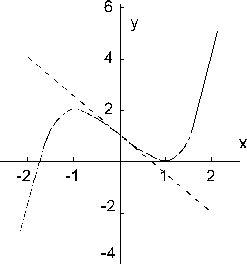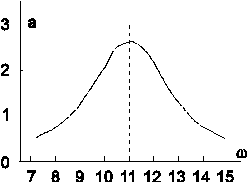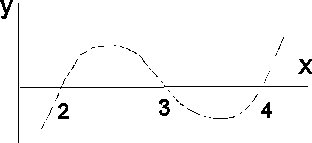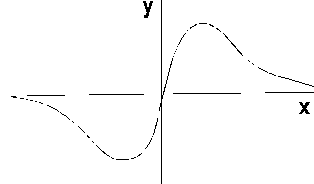 1. (a)
1. (a)
 1. (a)
1. (a)
| x | y = x3 - 2x + 1 |
| -2 | -3 |
| -1.5 | 0.625 |
| -1 | 2 |
| -0.5 | 1.875 |
| 0 | 1 |
| 0.5 | 0.125 |
| 1 | 0 |
| 1.5 | 1.375 |
| 2 | 5 |
For small values of x the leading term after the constant 1 is -2x. This has a negative multiplier, so the line passes through (x,y) = (0,1) with a negative slope. For large values of x the leading term is now x3 which is large and positive for positive large x; and is large and negative for large negative x. This explains the overall shape of the curve.
(b) 
| ω |  |
Note: this curve is symmetrical about the line ω = 11. This is because the denominator can be written as [(ω-11)2 + 4], and is thus the sum of two squares.
 2. (a)
Since y is the product of three factors it will take the
value zero when any one of the factors is itself zero. This will
occur for x = 2, x = 3, and x = 4. Furthermore,
if x 4 all three factors will be positive and thus y will
be positive, and for x 2 all three factors will be negative
and thus y will be negative. This is therefore another
cubic equation with a shape very similar to that of 1(a).
2. (a)
Since y is the product of three factors it will take the
value zero when any one of the factors is itself zero. This will
occur for x = 2, x = 3, and x = 4. Furthermore,
if x 4 all three factors will be positive and thus y will
be positive, and for x 2 all three factors will be negative
and thus y will be negative. This is therefore another
cubic equation with a shape very similar to that of 1(a).
 (b)
The numerator is zero for x = 0, so that the curve passes
through the origin (0,0). The denominator is the sum of the square
of x and a positive number, and is therefore always positive.
Thus y will be positive for positive x, and negative
for negative x. Finally, for large positive or negative
x the denominator will become much larger than the numerator,
so that y will tend to zero.
(b)
The numerator is zero for x = 0, so that the curve passes
through the origin (0,0). The denominator is the sum of the square
of x and a positive number, and is therefore always positive.
Thus y will be positive for positive x, and negative
for negative x. Finally, for large positive or negative
x the denominator will become much larger than the numerator,
so that y will tend to zero.
3. (a) 5x4 (b) 4x (c) 21x2
(d) 2x3 (e) 1½x5 (f) 3400x33
(g) 43.8x2 (h) 1.16x22.2
(i) 2![]() 104x3
104x3
4. Emphasise that we don't always use x and y, other symbols, even strange, unfamiliar ones may be used in Chemistry...
(a) 6p2 (b) 15 (c) 20h3
(d) 120z7 (e) 9x2 (f) 4½λ5
(g) 36ξ17 (h) 1½ζ2 (g) 63¥2